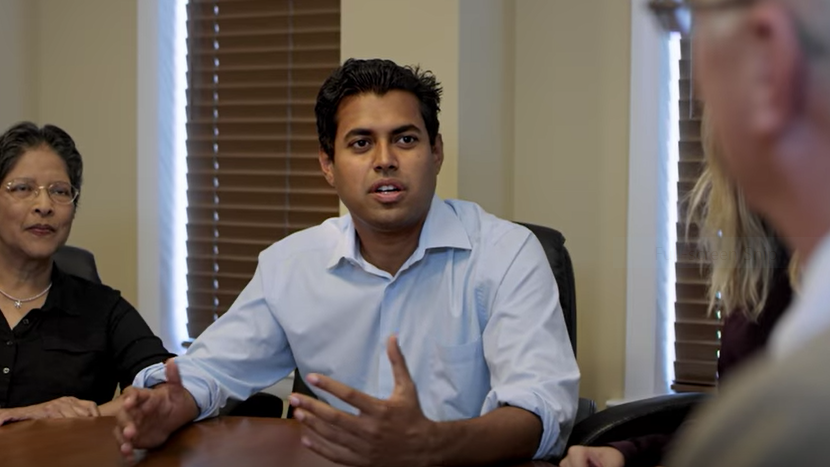
Senate Education Committee Chair Vin Gopal (D-11) wants the New Jersey Department of Education Commissioner Kevin Dehmer to address the school funding crisis affecting the most underserved communities in Monmouth County – Red Bank, Long Branch, Asbury Park and Neptune.
School districts in Legislative District 11 are scheduled to lose more than $16 million in state aid in the
coming fiscal year based on the state funding formula’s latest calculations.
“As it exists, the school funding formula is deeply flawed,” said Gopal. “It denies too many
districts the time and consistency they need to best serve their students. I appreciate Commissioner
Dehmer taking the time to discuss how we can help districts navigate these cuts and take steps to address the funding formula’s shortcomings going forward.”
Gopal reminded his constituents that he has been a persistent critic of the state’s school funding formula.
Assemblywomen Margie Donlon and Luanne Peterpaul, representing the 11th District, joined Gopal in
calling for change.
“We need supplemental funding and changes to the formula. Asbury Park, Long Branch, Neptune
Township, and Red Bank are the towns hit hardest by the cuts to funding, all of which have racially and
socio-economically diverse communities,” said Peterpaul.
“These Monmouth County communities who need the most support from us will suffer because of these
reductions. We need to do everything we can to not only restore funding to our schools, but also approach changes to the formula with the hindsight of the current funding crisis,” said Donlan.
In particular, the LD11 lawmakers are pushing for revisions to the method the formula uses to calculate a district’s wealth.
The formula uses a district’s property values and the incomes of district residents to calculate how much
funding the district is expected to raise through local property taxes. When property values and incomes
in a district rise, the formula assumes the district can raise more through taxes and cuts the level of state aid provided to the district proportionately.
All four districts saw their local tax obligations rise due to spikes in those wealth indicators, but leaders
from the districts stress those metrics have some glaring flaws that cause the formula to overestimate how much their district’s can raise through local taxes.
“There was no way to predict the $10 million loss in funding to our school district. We have consistently
gained aid each year under the formula until this year. With the very sudden and steep cut to our school
district, an almost 20% decrease from last year, the Long Branch schools could be forced into scaling
back services for students and staff in order to keep our schools running,” said Long Branch Mayor
John Pallone.
Gopal said the projected numbers this year are indicative of the unreliability and volatility of the formula, which needs to be addressed.
“The formula clearly is not calibrated to assess the needs of these communities. As the state is poised to
make an historic investment in New Jersey’s schools, these districts, which serve communities that need our support, are facing devastating cuts,” Gopal said.
While revising the formula remains the ultimate goal, the latest round of funding cuts has led community leaders to call for a more immediate solution, as well.
“After years of cuts to our district’s aid, we are faced with decisions we never thought we would have to
make,” said Asbury Park Mayor John Moor. “Unless some of this funding is restored, Asbury Park will be forced to cut critical services we provide to our students and families.”
Gopal said he has been collaborating with leaders from local towns that have been hit hard by the formula to strategize on solutions and emphasize the severity of their situation to the state.
Our students, staff, and their families all play their part in supporting and fostering a healthy learning
environment – their contributions shouldn’t be jeopardized by flaws in the state formula ,” shared Neptune Township Mayor Tassie York.
“As administrators, we plan for the upcoming school year to ensure that every child receives the support
they need. While we have lost funds each year due to the school funding formula, we did not plan to lose
over a third of our state aid, as we had a decrease of 34.8% in funds,” Mayor York added. “Consistency is critical to a school district’s success, and the volatility of this formula continues to hinder our district’s success.”
Red Bank Mayor William Portman said that after several years of funding uncertainty, his district is also struggling to maintain services that local residents have come to count on. “Red Bank Boro lost 19.6% in funding compared to the previous year. The volatility of the school funding formula is unacceptable,” Senator Gopal, Assemblywoman Donlon, Assemblywoman Peterpaul, Mayor Pallone, Mayor Moor, Mayor York, and Mayor Portman are calling on the state to provide assistance to districts that continue to struggle under the formula, and make meaningful revisions to the state funding formula.
(Visited 41 times, 41 visits today)
A recent analysis conducted by education policy expert Dr. Gopal has revealed deep flaws in the way school districts prioritize their funding. The study, which looked at funding allocations in several school districts across the country, found that resources are often not being distributed in a way that benefits all students equally.
One of the key findings of the analysis was that wealthier schools tended to receive more funding than schools in low-income areas. This disparity in funding can have a significant impact on the quality of education that students receive, as schools in low-income areas often lack the resources needed to provide a high-quality education.
Another troubling finding was that funding was often allocated based on factors such as test scores and graduation rates, rather than on the actual needs of students. This means that schools with higher-performing students may receive more funding, even if they do not necessarily need it, while schools with struggling students may be left without the resources they need to succeed.
Dr. Gopal’s analysis also revealed that funding priorities varied widely between school districts, with some districts investing heavily in technology and infrastructure, while others focused more on hiring additional teachers or providing support services for students. This lack of consistency in funding priorities can make it difficult for students to receive a consistent and high-quality education across different districts.
Overall, Dr. Gopal’s analysis highlights the need for school districts to reevaluate their funding priorities and ensure that resources are being allocated in a way that benefits all students. By addressing these deep flaws in funding allocation, school districts can work towards providing a more equitable and effective education system for all students.


